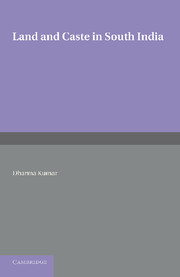 Land and Caste in South India
Land and Caste in South India Book contents
- Frontmatter
- Dedication
- CONTENTS
- List of Tables and Figures
- Acknowledgements and A Note on Certain Connventions
- Abbreviations
- Map of the Madras Presidency
- PART I
- I INTRODUCTION
- II THE AGRARIAN BACKGROUND
- III FORMS OF AGRESTIC SERVITUDE
- IV THE IMPORTANCE OF AGRICULTURAL LABOUR IN THE FIRST HALF OF THE NINETEENTH CENTURY
- V OFFICIAL POLICY AND THE EMANCIPATION OF THE AGRICULTURAL LABOURER
- VI OFFICIAL POLICY: LAND TENURES AND LAND REVENUE
- PART II
- Glossary
- Bibliography
- Index
II - THE AGRARIAN BACKGROUND
from PART I
Published online by Cambridge University Press: 05 June 2016
- Frontmatter
- Dedication
- CONTENTS
- List of Tables and Figures
- Acknowledgements and A Note on Certain Connventions
- Abbreviations
- Map of the Madras Presidency
- PART I
- I INTRODUCTION
- II THE AGRARIAN BACKGROUND
- III FORMS OF AGRESTIC SERVITUDE
- IV THE IMPORTANCE OF AGRICULTURAL LABOUR IN THE FIRST HALF OF THE NINETEENTH CENTURY
- V OFFICIAL POLICY AND THE EMANCIPATION OF THE AGRICULTURAL LABOURER
- VI OFFICIAL POLICY: LAND TENURES AND LAND REVENUE
- PART II
- Glossary
- Bibliography
- Index
Summary
South India is differentiated from the rest of India both by the importance of pre-Aryan elements in its social structure and by the fact that Muslim invasions came much later than in the North and did not leave so deep an impact. Mahmud of Ghazni invaded the Punjab early in the eleventh century, and there had been Arab invasions of Sind even earlier, but it was not till the end of the thirteenth century that a Muslim army invaded the South.
The Aryanization of the South may have started around 1000 B.C., little is known about the Dravidian society that existed before that date. The degree of contact between North and South India fluctuated; at some periods North Indian empires such as the Maurya spread to South India; at times South Indian rulers such as the Andhra dynasty, the Satavahanas, encroached into the North, but for large expanses of time there was little contact between the two areas. The Satavahanas, whose rule lasted for four and a half centuries till around 230 B.C., were followed by many warring dynasties, including the Cheras, the Chalukyas, the Pallavas, the Pandyas, the Rashtrakutas and the Cholas, who ruled from A.D. 850 to 1200, and traces of whose achievements in the fields of administration and irrigation still remain.
The decline of the Chola empire was followed by a century of warfare, which culminated in the first Khalji expedition to the Deccan in 1296. Many other Muslim incursions from Delhi followed, and at one stage in the early fourteenth century, Muslim historians claimed, the whole of South India was part of the empire of Delhi. Yet the Sultan's power in the South was almost everywhere weak, and it was overthrown by the rise in the fourteenth century of the Hindu empire of Vijaynagar which grew to cover almost the whole of South India. Throughout its history the Vijaynagar empire was threatened by a hostile power nearer at hand, the Bahmani Sultanate of the Deccan, and after the decisive victory of the Bahmanis in 1565, the empire disintegrated. In the anarchy that followed small chieftains called naiks or poligars seized local authority, but few of these established permanent rule, and in most of South India power gradually passed into the hands of the Sultans of Bijapur and Golkonda.
- Type
- Chapter
- Information
- Land and Caste in South IndiaAgricultural Labour in the Madras Presidency during the Nineteenth Century, pp. 6 - 33Publisher: Cambridge University PressPrint publication year: 2013


